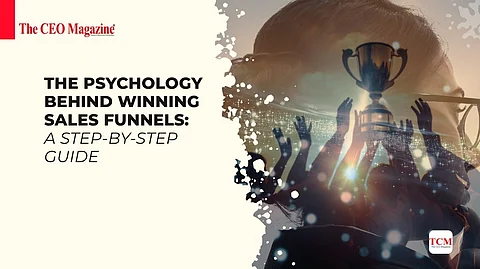
- News
- Women
- Magazine
- IndustryIndustry
- InsightsInsights
- Success Stories
- PublishPublish
- ContactContact
- Media KitMedia Kit

Let me ask you something:
Have you ever been so convinced by a product that you clicked "Buy Now" without hesitation?
That wasn’t a lucky break for the business — it was the power of psychology-driven sales funnels at work.
In today’s competitive landscape, having a sales funnel isn’t enough.
To scale revenue, convert leads, and win loyal customers, your funnel must speak directly to the emotions, biases, and behaviors of your audience.
Here’s the secret:
“Great sales funnels aren’t built on guesswork — they’re engineered with psychology.”
In this article, I’ll walk you through the step-by-step psychology behind high-converting sales funnels, and how you can build one for your startup, brand, or business that actually works — not just looks good on a pitch deck.
In my experience advising founders and marketers, I’ve seen one pattern repeat itself:
Funnels that convert are grounded in human behavior — not just tech automation.
Humans buy based on:
Emotion first, logic later.
Trust, not just price.
Relevance over reach.
Neuromarketing research shows that 95% of purchasing decisions happen subconsciously. That means your funnel needs to tap into emotional triggers — curiosity, urgency, trust, fear of missing out (FOMO), and social proof.
Let’s break it down, step by step.
At the top of your sales funnel, you’re not selling.
You’re earning attention.
Curiosity: Use headlines and content that raise questions.
Problem-agitation: Highlight your customer’s pain points vividly.
Example:
Instead of “Affordable Accounting Software,” say
“Still Losing Sleep Over Your Business Finances? Here’s a Smarter Way.”
Pro tip: Your ad copy or social content should stop the scroll. This is where emotional resonance beats product features.
Once they’re aware, they’re not ready to buy yet.
They’re asking, “Is this legit? Can this help me?”
Lead magnets: Free downloads, tools, webinars — but make them genuinely valuable.
Social proof: Testimonials, reviews, user-generated content.
Authority building: Feature logos, press mentions, and certifications.
In my campaigns, I often include a lead magnet like “Free Business Growth Checklist,” and follow it with case studies that show transformation — not just results.
This is the decision-making zone.
Here’s where psychology does the heavy lifting.
Anchoring: Show a high-priced offer first, then present your “core” offer as more attractive.
Scarcity & Urgency: “Only 3 slots left,” or “Expires in 24 hours.”
Reciprocity: Give before you ask. Give more than expected.
Example from a D2C brand:
They showed a ₹7999 skincare kit, followed by a ₹2999 “starter kit” with bonus samples. Sales of the starter kit increased by 38% after this small tweak.
Most sales are lost at the checkout or sign-up page. Why?
Because the process is confusing, slow, or unclear.
One clear CTA (Call-to-Action): Not five.
Trust badges: SSL, money-back guarantee, secure checkout icons.
Short forms: The fewer fields, the better.
“A confused mind always says no.” — Donald Miller
Imagine this: You’ve earned trust, you’ve built desire — don’t lose the sale to a clunky form or distracting design.
You’ve got the sale. Now what?
Smart founders know this is just the beginning.
Trigger dopamine: Deliver surprise bonuses post-purchase.
Reinforce identity: “You’re now part of an elite group of business leaders.”
Build community: Invite to private groups, events, or early-access launches.
In one SaaS company I advised, a personalized thank-you video and onboarding sequence increased retention by 24% in 3 months.
Here are a few psychological hacks that have worked wonders in high-converting funnels:
Here are a few tools I’ve used or recommended:
ClickFunnels – For quick funnel deployment with upsell paths.
Leadpages – High-converting landing page templates.
ConvertKit – Email automation with behavior-based triggers.
Hotjar – Visual heatmaps to track user behavior and friction.
Intercom – Personalized messaging during crucial funnel stages.
Here’s what I want you to take away:
Winning sales funnels aren’t manipulative — they’re magnetic.
They feel like conversations, not pitches.
If you understand the psychology of your customer — their fears, desires, doubts, and dreams — you won’t need to push.
You’ll simply guide them to a decision that feels right.
So ask yourself:
Are your funnels built on features or feelings?
Are you following trends or understanding human behavior?
Because in today’s world, it’s not about having the fanciest funnel — it’s about building the smartest one.
Want help building your own psychology-based sales funnel?
Check out our detailed resources and guides in our Marketing Strategy section.
Follow us on Google News
